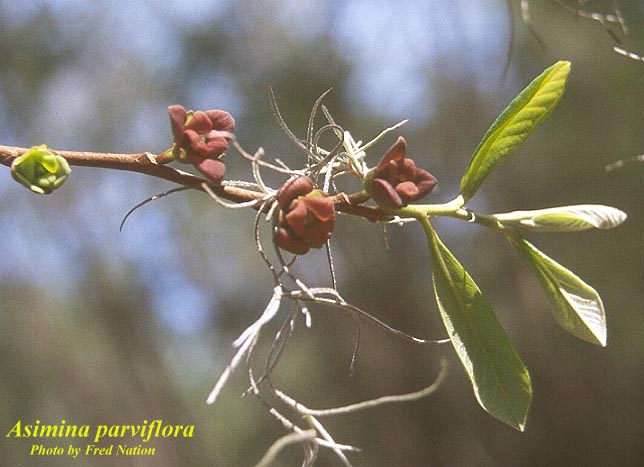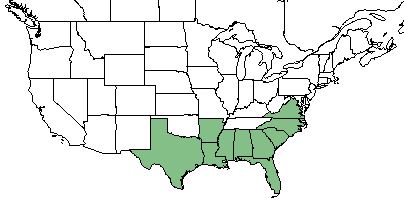Asimina parviflora
Common names: small-flowered pawpaw, small-fruited pawpaw
| Asimina parviflora | |
|---|---|

| |
| Photo by the Atlas of Florida Plants Database | |
| Scientific classification | |
| Kingdom: | Plantae |
| Division: | Magnoliophyta - Flowering plants |
| Class: | Magnoliopsida - Dicots |
| Order: | Magnoliales |
| Family: | Annonaceae |
| Genus: | Asimina |
| Species: | A. parviflora |
| Binomial name | |
| Asimina parviflora (Michx.) Dunal | |

| |
| Natural range of Asimina parviflora from USDA NRCS Plants Database. | |
Contents
Taxonomic Notes
Synonyms: none[1]
Varieties: none[1]
Description
A. parviflora is a perennial shrub tree of the Annonaceae family native to the southeastern United States.[2] Alternately arranged leaves that are simple, obovate or oblanceolate to oblong, entire, and pointed at the tip are up to 8 inches long and possess some hairs on the veins of the lower surface. The maroon bisexual flowers that are solitary, located in axils of the leaf scars, have a slightly bad odor. The fruits are berries that are greenish yellow and up to 3 inches long.[3]
Distribution
A. parviflora is found in the southeastern United States, particularly in Florida, Georgia, South Carolina, North Carolina, Alabama, Mississippi, Louisiana, Arkansas, and Texas. [2]
Ecology
Habitat
A. parviflora is found in the Coastal Plain of the southeastern United States[4] on sparse loamy sands, moist sands, floodplains, woodland slope, and bottomland hardwood forests.[5] A. parviflora has been observed in dry-mesic hardwood hammock on a bluff above the Kissimmee River in Highland County Fl. This specimen is on the edge of it's southeastern range. .[6]
A. parviflora was found to decrease its cover in response to soil disturbance by clearcutting and chopping in North Florida flatwoods forests. It has also shown resistance to regrowth in reestablished flatwood forests that were disturbed by clearcutting and chopping.[7]
Phenology
The A. parviflora flowers are the smallest in the Asimina genus with 4-6 maroon flowers per branch. The flowers are in bloom from February to May depending on the year. [4] It has been observed flowering in June as well.[8]
Seed dispersal
The A. parviflora is pollinated by insects including the greenbottle fly and nitidulid beetles.[4] This species is thought to be dispersed by consumption by vertebrates. [9]
Seed bank and germination
The fruit from A. parviflora requires an average of 3-4 months to mature and the number of seeds germinated is low compared to the initial population developed. [4]
Pollination
A variety of flies are the most common visitor to the A. parviflora but they have not been traced to pollination, which is largely a result from beetles and the greenbottle fly.[4]
Herbivory and toxicology
It comprises 2-5% of diet for small mammals and terrestrial birds.[10]
Conservation, cultivation, and restoration
Cultural use
The fruit of A. triloba is known to be sweet and custard-like. It was often used in baking, pie filling, or eaten raw. The fruits fall from the tree early and must be harvested from the ground to ripen later.[11] For medicinal purposes, the seeds can be used to induce vomiting or to treat head lice when powdered, and the fruit juice can be a treatment for intestinal worms.[12] Caution should be exercised though, as some people exhibit an allergic reaction of dermatitis to the fruit.[13]
Photo Gallery
References and notes
- ↑ 1.0 1.1 Weakley, A.S. 2020. Flora of the Southeastern United States. Edition of 20 October 2020. University of North Carolina at Chapel Hill, Chapel Hill, North Carolina.
- ↑ 2.0 2.1 USDA Plant Database
- ↑ [[1]] Lady Bird Johnson Wildflower Center. Accessed: March 25, 2019
- ↑ 4.0 4.1 4.2 4.3 4.4 [Norman, E. M., et al. (1992). "Reproductive Biology of Asimina parviflora (Annonaceae)." Bulletin of the Torrey Botanical Club 119(1): 1-6.]
- ↑ URL: http://herbarium.bio.fsu.edu. Last accessed: June 2018. Collectors: Loran C. Anderson, Robert K. Godfrey, William Platt, M. Darst, H. Light, P. Isom, L. Peed. States and counties: Florida (Wakulla, Jefferson, Franklin, Leon, Lafayette), Georgia (Thomas)
- ↑ Observation by Edwin Bridgesr in Highlands County, Fl. on the kissimmee River, February 8, 2016, posted to Florida Flora and Ecosystematics Facebook Group February 8, 2016.
- ↑ Moore, W.H., B.F. Swindel, and W.S. Terry. (1982). Vegetative Response to Clearcutting and Chopping in a North Florida Flatwoods Forest. Journal of Range Management 35(2):214-218.
- ↑ Nelson, G. PanFlora: Plant data for the eastern United States with emphasis on the Southeastern Coastal Plains, Florida, and the Florida Panhandle. www.gilnelson.com/PanFlora/ Accessed: 25 MAR 2019
- ↑ Kirkman, L. Katherine. Unpublished database of seed dispersal mode of plants found in Coastal Plain longleaf pine-grasslands of the Jones Ecological Research Center, Georgia.
- ↑ Miller, J.H., and K.V. Miller. 1999. Forest plants of the southeast and their wildlife uses. Southern Weed Science Society.
- ↑ Fernald, et al. 1958. Edible Plants of Eastern North America. Harper and Row Publishers, New York.
- ↑ Korchmal, Arnold & Connie. 1973. A Guide to the Medicinal Plants of the United States. The New York Times Book Company, New York.
- ↑ Burrows, G.E., Tyrl, R.J. 2001. Toxic Plants of North America. Iowa State Press.